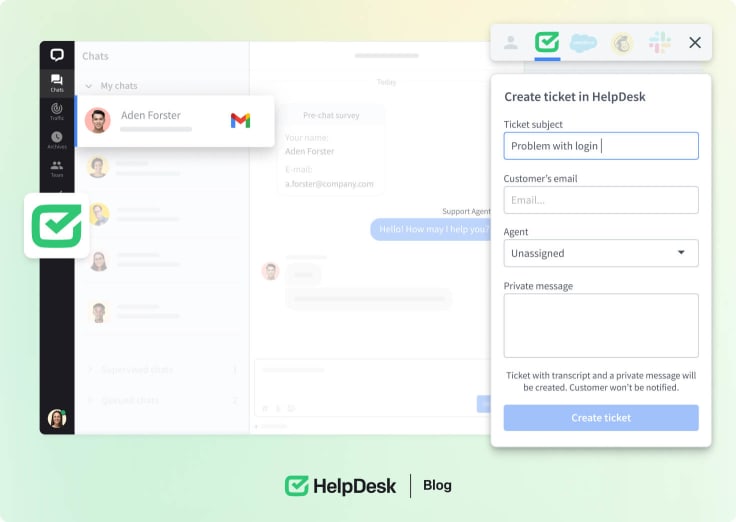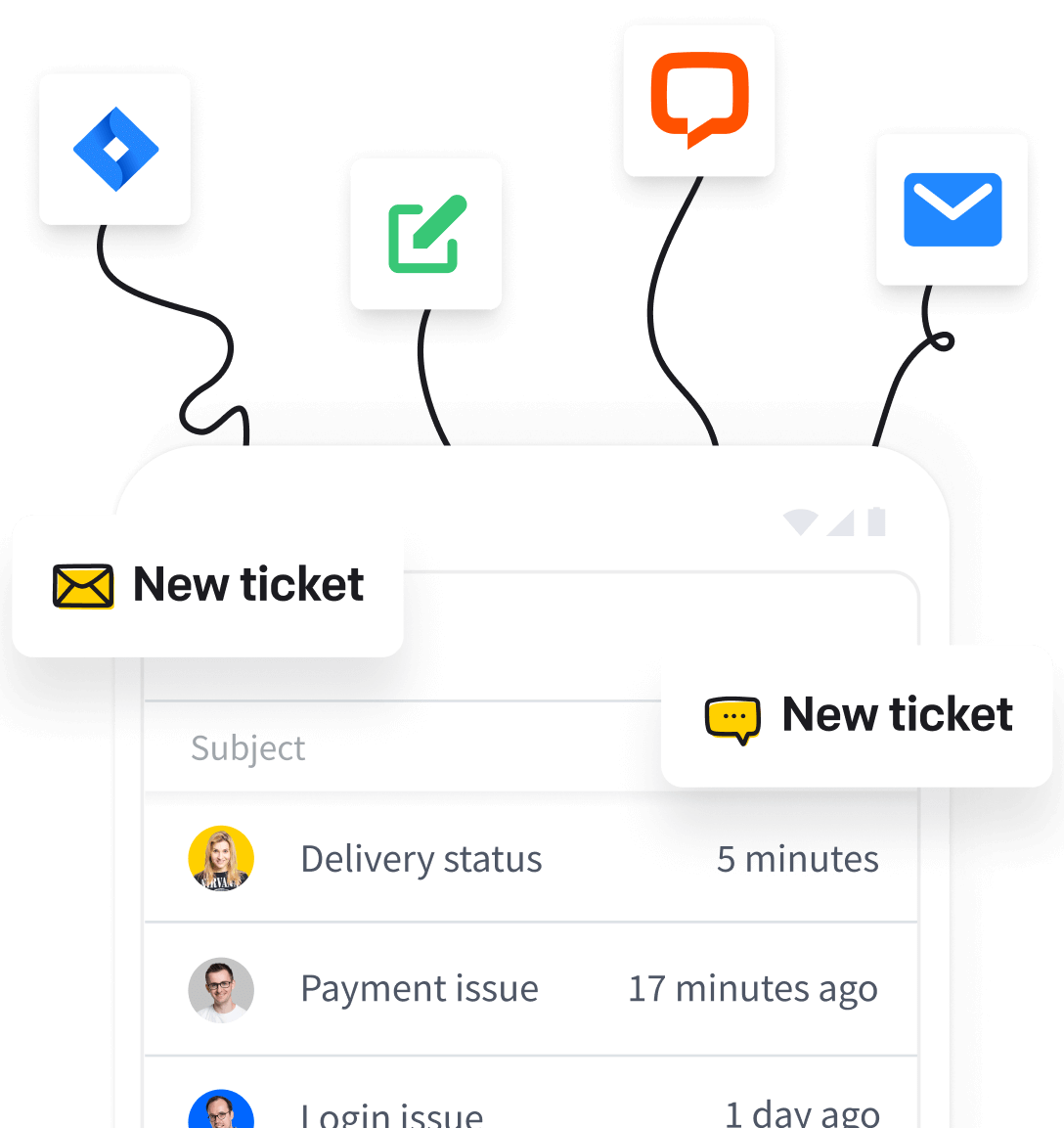Top 10 Customer Service Tips to Deliver a Better Customer Experience
Zuzanna Bocian

You want to care for your customers at the highest level every day. I know that. So, you’re trying the best shots, tricks, and strategies. Every day, you want to be better for them, and you want your team to deliver exceptional customer support to keep customers happy.
Dealing with customers’ issues, inquiries, and questions can be difficult and prone to errors, but with determination and dedication, you can improve daily.
In this guide, I gathered customer service tips and tricks that might help you provide better customer support. Are you ready to learn customer service best practices?
What is great customer service?
Great customer service support is essential for any business to thrive. It is centered around three key elements: empathy, adaptability, and a commitment to meeting customers’ evolving needs.
Empathy involves understanding and connecting with customers emotionally and relating to their challenges and concerns.
Adaptability is another crucial aspect of good customer service. Customer needs can change quickly, and support teams must be flexible and capable of adjusting their approach to accommodate evolving circumstances and preferences.
Every time you interact with a customer, you have an opportunity to either strengthen or weaken the relationship with them. If you provide a positive experience to the customer, they are more likely to return for future transactions and recommend your brand to others. Research shows that the probability of selling to an existing customer is much higher (between 60% to 70%) as compared to a new customer (which is only between 5% to 20%). This highlights that repeat business is valuable and is fostered by positive experiences (source).
On the other hand, negative experiences can lead to customer churn, reputational damage, and lost revenue.
I’ll explore these topics more deeply in the following parts of this article.
Why improving customer service is so important
A positive experience with customer service can create a sense of trust, satisfaction, and connection between the customer and the brand, with 61% of consumers willing to continue buying from a trusted brand even at risk (source).
On the contrary, a negative experience can harm trust and raise doubts about the brand, product, or service.
Customer service also contributes to the development of brand equity, which is the intangible value and reputation attached to a brand. Customers are likelier to trust and remain loyal to a brand that effectively meets their needs, as highlighted by PWC’s finding that 86% of customers are willing to pay more for a better customer experience (source).
Good customer service can lead to increased customer satisfaction, which has a ripple effect across various aspects of a business. Satisfied customers are likelier to become brand advocates, promoting the brand through recommendations and positive online reviews. For instance, businesses focusing on customer service see a 60% higher profitability compared to those that do not (source).
How to improve customer satisfaction
Well, I showed you what exceptional customer service should be. How can you do it? Let’s grab some coffee and dive deep into these customer service tips.
#1 Create memorable customer experiences
Customers appreciate genuine and customized interactions more than ever. You can foster long-lasting relationships and set yourself apart from competitors by implementing strategies such as:
-
addressing customers by name,
-
personalizing their experiences,
-
rewarding loyal customers,
-
showing empathy toward their needs and concerns.
Over 39% of customers would spend more with a brand they’re loyal to, even if cheaper options are available elsewhere (source).
Let’s see how you can do it.
Use the customer’s name
Using a customer’s name is a simple yet powerful way to enhance the user experience and foster a deeper connection between you and your buyers. Whether in face-to-face interactions, over the phone, via email, or even in surveys, addressing customers by name adds a personal touch that can leave a lasting impression.
Take Starbucks, for example. Their employees use customers’ names when greeting them, taking orders, and expressing gratitude for their patronage. This practice humanizes the interaction and builds recognition and mutual respect.

Moreover, incorporating customers’ names into communications can help you stand out in a crowded marketplace. In a world where consumers are bombarded with generic marketing messages and impersonal interactions, personalized attention can make a significant impact.
Take care of personalization
As we’re already at personalization.
Reaching out to customers personally to show that you care about their needs and preferences is essential. You can achieve this by sending a personalized email to ask about their experience or offer assistance. Even if they don’t accept your offer, they’ll appreciate the gesture and remember it positively.
First impressions matter, so adopting a friendly and conversational tone can help create a customized experience, so avoid overly formal language.
A personalized email address, such as “john@business.com” instead of a generic corporate one, adds a human touch to the communication. It reinforces the idea that the message comes from a real person who cares rather than a faceless entity.

Reward loyal customers
Loyalty programs are an excellent way to reward existing customers for their ongoing support and engagement. These programs repeat purchases and advocacy, encouraging customer loyalty while providing valuable insights into consumer preferences and behaviors.
One way to reward customers is by creating experiences that resonate with their interests and preferences. For example, if you own a bakery and want to show gratitude to your long-term customers, instead of offering free bread or merchandise, consider surprising them with a personalized bakery tour.
You could also enhance the experience by customizing labels with each customer’s photos, names, or other relevant information. This personalized touch adds a unique element to the gift and reinforces the idea that the experience is tailored specifically to them.

Rewarding customers through personalized experiences effectively builds brand loyalty and drives business growth.
Learn to empathize with your customers
Empathy is the ability to understand and share the feelings and perspectives of others, especially those of your customers. When you prioritize empathy, you create an environment where customers feel heard, understood, and valued, increasing satisfaction and loyalty.
However, many customer service representatives need help displaying empathy, often relying on scripted responses or impersonal interactions. It’s crucial to provide training and support to your customer service team to cultivate an empathetic mindset that encourages reps to put themselves in the customer’s shoes.
One strategy is to discuss concrete examples of customer issues, allowing reps to gain insights into the challenges customers face and understand the impact of their actions.
For instance, let’s consider a scenario where a customer is experiencing difficulties with a billing dispute. By discussing the specific details of the situation and exploring potential solutions, you can develop a deeper understanding of the customer’s perspective and the emotions involved.
Fostering a culture of empathy within the organization is essential for promoting empathetic behavior among customer service reps. Leaders should set an example, demonstrating empathy in their interactions with customers and employees.
Take care of your users and customize all your asynchronous communication 💻 Try a free 14-day trial of HelpDesk to boost your customer satisfaction 🚀

#2 Use the right tools to boost speed and efficiency
One of the significant advantages of using appropriate support tools is understanding your customers better. With features like built-in customer profiles, you can access valuable information about each customer, such as their history, preferences, and previous interactions. This lets your team personalize their responses and provide more tailored support, leading to higher customer satisfaction and loyalty.
For instance, HelpDesk offers various features that help you streamline your communication with users. You can explore custom fields, automation, macros, and many more. With a comprehensive view of each customer, support agents can better understand their needs and preferences, resulting in more meaningful customer conversations and better outcomes.
Moreover, using dedicated service support platforms ensures that your team is equipped with the right tools for the job. Support platforms facilitate efficient communication, collaboration, and problem-solving, enabling your team to meet customer expectations better and deliver a superior user experience.
Relying on the proper support tools can help avoid common pitfalls, undermining customer satisfaction. Cumbersome processes or inadequate information management can frustrate customers and damage your brand reputation. Investing in tools that streamline support workflows and centralize customer data can minimize the risk of errors and ensure that every interaction with your brand is positive and memorable.
✅ Provide care for your customers synchronously and asynchronously. Check out HelpDesk's integration with LiveChat 🦸, which delivers a high customer experience.

#3 Don’t apologize, create solutions
As humans, we’re accustomed to apologizing. However, when it comes to customer support, there are better approaches than apologizing for everything, especially issues beyond our control.
Although apologies may sometimes be necessary for customer interactions, reducing their frequency can help sustain customer satisfaction and maintain the credibility of your brand.
Here are several strategies to avoid making apologies in customer service:
-
Preventative measures. Take proactive steps to identify and address potential issues before they impact customers. Regularly monitor systems, processes, and customer feedback to identify areas for improvement and implement solutions proactively.
-
Empowerment and training. Empower customer service reps with the knowledge, tools, and authority to resolve customer issues effectively. Provide comprehensive training on products, services, and communication techniques to efficiently equip agents with the skills to address customer inquiries and concerns.
-
Prompt resolution. Prioritize prompt resolution of customer issues to prevent dissatisfaction from escalating. Implement efficient processes and workflows to address buyer inquiries promptly.
-
Proactive support. Anticipate and address customer needs before they arise by providing proactive support and guidance. Offer self-service resources, such as FAQs, tutorials, and knowledge bases, to help customers find answers to common questions and troubleshoot issues independently.
-
Quality assurance. Implement measures to ensure customer service interactions meet established standards for professionalism, accuracy, and customer satisfaction. Regularly review and assess support interactions to identify areas for improvement and provide targeted coaching and training to agents as needed.
You can maintain positive customer relationships by proactively preventing issues rather than apologizing after they occur.
#4 Use positive language
Customer service representatives must use positive and constructive language when communicating with customers.
For example, informing the customer of the delay is important when a product is on backorder for a month. By framing the message positively and constructively, the customer service representative can help the customer understand the situation and provide alternative options, which may help to alleviate any frustration or disappointment.
The way this information is communicated can significantly impact the customer’s perception and response:

In this example of positive language, the attention is shifted from the issue (namely the backorder) to the proposed solution (meaning placing the order now and ensuring prompt shipment). By framing the message positively and providing a proactive solution, the customer is more likely to feel reassured and satisfied with the outcome.
Instead of saying, “Sorry, we don’t have that item right now,” customer service representatives can say, “I understand you were hoping to purchase this today, and I apologize that we currently have none in stock. A new shipment is scheduled to arrive next Tuesday, and if you wish to come back then, I’d be happy to hold one for you once they come in. I can call you to let you know when they’ve arrived.”
This response demonstrates empathy by acknowledging the customer’s disappointment while providing a proactive solution and offering assistance.
#5 Provide quick and efficient support
Customers expect prompt and satisfactory responses when they encounter issues with your products or services or have inquiries about your brand. With limited free time available, customers are increasingly more relaxed about lengthy interactions with the team, as even a short delay can significantly impact their satisfaction levels.
These expectations aren’t merely speculative. Research corroborates this sentiment. Almost two-thirds of online adults in the US believe that valuing their time is the most important thing a brand can do to provide them with a good customer experience (source).
Try omnichannel solution
Have you considered implementing omnichannel support for your business?
This approach involves creating a comprehensive customer experience strategy that covers all channels where your clients are active. Given that modern consumers use various channels and devices for their interactions, it’s essential to ensure that your support strategy accommodates this diversity.
For instance, if you operate a chain of retail stores, your omnichannel support strategy should encompass various forms of support. These include, for example:
-
in-person interactions with staff,
-
social media support tailored to your customers’ platforms,
-
mail support hone assistance,
-
tickets management,
-
live chat messaging.
The ultimate goal is to ensure customers have a seamless experience, regardless of the channel they engage with your brand.
Focus on social media platforms
When customers use social media to contact your brand for assistance, raise a complaint, or ask questions, they expect a fast, proactive, easy, and accessible response. Responding promptly on social media is critical, as research indicates that many customers expect an almost immediate reply from brands when they engage on social platforms.
For example, approximately 42% of customers anticipate a response within 60 minutes after posting a complaint, with 32% expecting a reply within 30 minutes (source).
It’s important to meet customers’ expectations for social media support, as failing to do so can harm your brand’s reputation. Customers who have to wait for support on social media may share their dissatisfaction with others, which could increase negative sentiment.
However, if you use social media for customer support, you can not only meet the expectations of modern consumers but also improve your brand’s reputation and generate customer advocacy.
Provide self-service options
An effective way to provide self-help features is by creating a strong knowledge base or FAQ section. You can develop comprehensive articles and step-by-step tutorials by identifying common questions and complaints to help customers resolve issues independently.
To make these resources more accessible, you can integrate the FAQ/knowledge base section with automated email replies. This lets customers quickly find the information they need while waiting for personalized assistance. Customers can resolve their concerns without additional support by including a direct link to the resource in email communications.
#6 Listen and ask your customers questions
Listening to customer questions and feedback is vital to understanding their needs, preferences, and pain points. It can improve products, services, sales growth, and overall customer satisfaction. Instead of waiting for feedback, you should proactively seek customer input through various channels and methods.
For instance, you can use customer feedback software to send surveys after purchases or interactions with the support team to gather valuable insights and gauge their satisfaction levels. Running social media polls can also provide real-time feedback on different aspects of the customer experience and identify areas for improvement.
Surveys are especially important when introducing new features, products, or services. They allow you to assess customer reactions and expectations before deployment, minimizing risks and ensuring alignment with customer needs.
Learn more about getting customer feedback and using it to improve your services 📚 Read the Learning Space lesson: How To Get Customer Feedback and Measure Satisfaction. 💹

#7 Keep standards high and response times low
Maintaining high standards and efficiently managing email inquiries can be achieved through simplicity. One effective method is addressing basic and frequently asked questions using scalable templates that significantly reduce response times and minimize repetitive queries. Support teams can create standardized responses for common inquiries using saved replies, resulting in consistent and efficient customer communication.
The key value of saved replies lies in their scalability and versatility. As the entire team contributes to building and refining these templates, they become increasingly valuable over time. Establishing clear guidelines for identifying common questions and determining when a saved reply is appropriate ensures consistency and accuracy in customer interactions.
#8 Align your customer journey touchpoints
A customer journey touchpoint is defined as any interaction that a customer has with your brand. This interaction could be through your website, a phone call, an email exchange, or a social media interaction. You can maintain consistent messaging, branding, and service delivery by aligning all touchpoints.
Here are key steps to align your user journey touchpoints in customer service:
-
Map the customer journey. Start by mapping out the various stages of the journey, from awareness and consideration to purchase and post-purchase support. Identify all the touchpoints where customers interact with your brand during each stage.
-
Consistent branding. Ensure that your branding elements, including logo, colors, tone of voice, and messaging, are consistent across all touchpoints. This helps reinforce brand recognition and creates a unified brand experience for customers.
-
Integrated systems. Integrate your support systems with other customer-facing systems, such as CRM software, helpdesk, and ecommerce platforms. This enables seamless data sharing and ensures customer information is accessible across all touchpoints, allowing support agents to provide personalized and efficient service.
Training and guidelines. Train your support team on delivering a consistent customer experience across all touchpoints. Develop guidelines and best practices for handling customer inquiries, resolving issues, and communicating with customers in a professional and empathetic manner.

#9 Know how to close a conversation
Good closure of conversations with customers is a crucial aspect of providing exceptional customer support. It doesn’t necessarily mean closing a sale but signifies resolving the customer’s issue or query, leaving them satisfied with their interaction with your brand.
Leaving a conversation unresolved can lead to unnecessary complications and potential customer dissatisfaction. Often, customers hold back from expressing dissatisfaction because they perceive a need for care or attention from the company.
Simple phrases like “Is there anything else I can do for you today? I’m happy to help!” provide opportunities to ensure that all customer needs have been addressed comprehensively. Additionally, ensuring that customers leave the conversation with a clear affirmation of satisfaction, such as “Yes, I’m all set,” reaffirms that their concerns have been adequately addressed and resolved.
#10 Monitor performance metrics
It’s crucial to balance monitoring key metrics and avoiding data overload. Instead of focusing solely on individual metrics, it’s essential to consider the big picture, aligning your tracking efforts with organizational goals and customer needs.
Key support metrics like net promoter score (NPS) and customer satisfaction scores (CSAT) provide valuable insights into overall customer sentiment and loyalty. These metrics help gauge customer satisfaction levels and identify areas for improvement in the customer experience. Tracking metrics related to upsells, cross-sells, and customer churn can provide valuable insights into customer retention and revenue generation. You can read more about these metrics in my Customer Retention Guide.
However, the key is staying calm by tracking only a few metrics. Instead, focus on a few that provide your team with the most relevant and actionable insights. Regular analysis of these metrics over time allows you to identify trends, patterns, and areas for improvement, empowering you to make data-driven decisions and enhance the overall user experience.
Do you want to follow your customer support metrics? Try a free 14-day trial and join HelpDesk! 🤝

Invest in excellent customer service skills
Throughout this article, we’ve explored various aspects of exceptional customer service operations and support and its critical role in shaping the overall customer experience. From discussing the importance of empathy and adaptability in customer interactions to highlighting the significance of personalized service and timely responses, it’s evident that good customer service is essential for business success. I also showed you many of the customer service tips I know.
It underscores the idea that a skilled customer support team is instrumental in fostering positive customer relationships, driving loyalty, and ultimately contributing to business growth. You can overcome challenges, address customer needs, and succeed in a competitive marketplace with dedicated and proficient customer service agents.
Now that you’ve read this long piece, did you find any ideas that you plan to implement in your company?


Get the cheat sheet for solving customer tickets
Join our newsletter to receive your cheat sheet and other amazing content directly in your inbox.
Success! You're one click away from the cheat sheet 👇
Open now